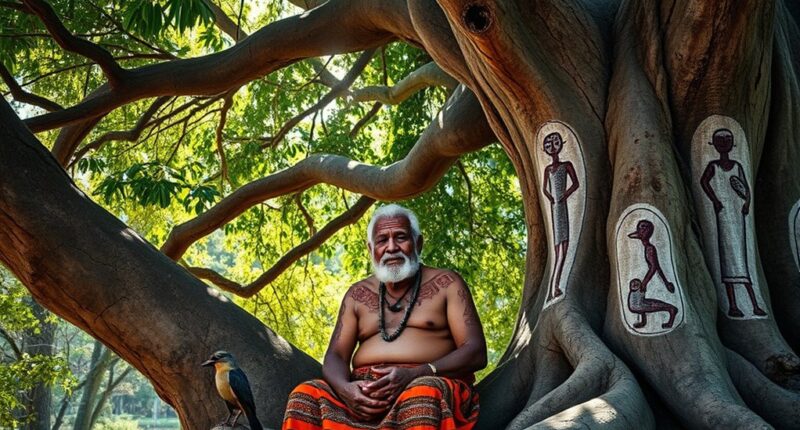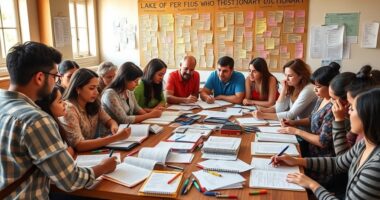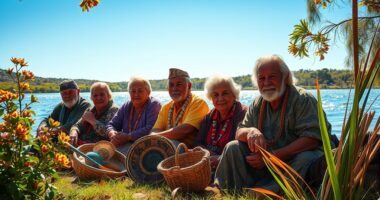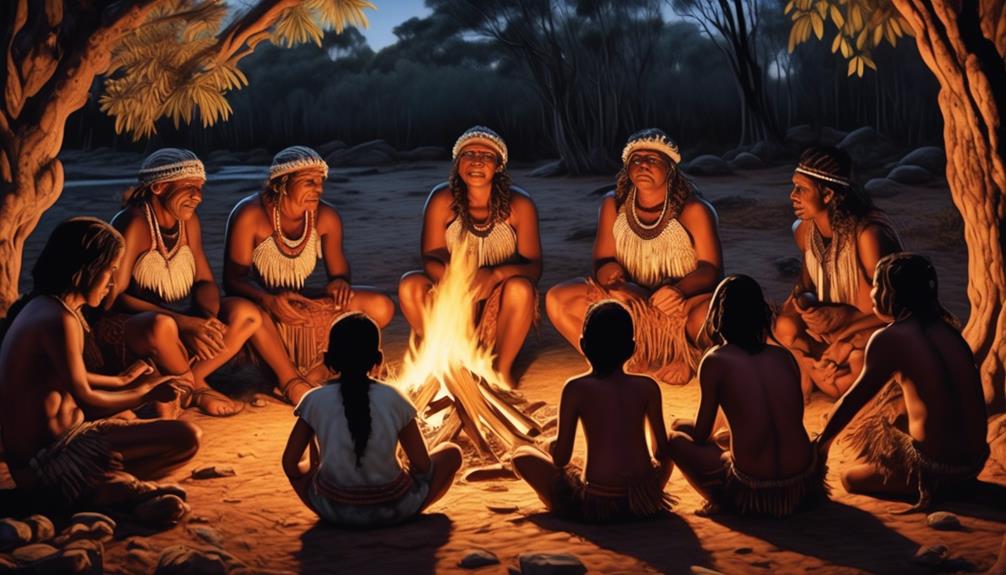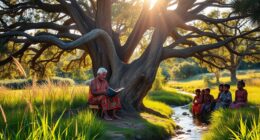Dharawal and Dharug are the traditional languages of Sydney’s Indigenous peoples, representing more than just words—they embody stories, land, and cultural identity. These languages reflect the worldview and values of local communities and are deeply tied to specific places and natural elements. Efforts are underway to preserve and revive them through classes and cultural projects, ensuring these essential traditions continue. If you keep exploring, you’ll learn even more about how these languages connect Aboriginal history to modern Sydney.
Key Takeaways
- Dharawal and Dharug are Indigenous languages spoken by Sydney’s traditional custodians before European settlement.
- These languages embody cultural stories, land connections, and community identity beyond just communication.
- Preservation efforts include language classes, recordings, and educational resources to revitalize and embed them in daily life.
- Language revival demonstrates resilience, fosters reconciliation, and deepens understanding of Sydney’s Indigenous history.
- Protecting Dharawal and Dharug ensures the continuation of cultural heritage and enriches Sydney’s historical narrative.

Have you ever wondered what languages were spoken by Sydney’s Indigenous peoples before European settlement? The rich tapestry of languages like Dharawal and Dharug reveals much about the cultural significance they held for their communities. These languages weren’t just tools for everyday communication; they embodied the stories, traditions, and identity of the people. For the Dharawal and Dharug communities, language preservation is essential in maintaining their cultural heritage. It’s a way to keep their history alive, passing it down through generations despite the challenges posed by colonization and modern influences.
Sydney’s Indigenous languages like Dharawal and Dharug preserve stories, culture, and identity across generations.
Dharawal and Dharug are more than just words and grammar—they’re living expressions of culture. When you learn about these languages, you gain insight into the worldview, values, and relationship with the land that define these communities. Words often carry meanings tied to specific places, seasons, and natural elements, making language preservation a form of cultural stewardship. By keeping these languages alive, communities reaffirm their identity and foster a sense of pride and belonging. It’s about honoring ancestors and guaranteeing that future generations can connect with their roots.
Efforts to revive and sustain Dharawal and Dharug languages are ongoing, driven by community members, linguists, and cultural organizations. These initiatives include language classes, recording oral histories, and creating educational resources. The goal is to embed the languages into daily life and guarantee they are not lost to history. For many Indigenous Australians, language is a pivotal part of cultural revival, serving as a bridge between past and future. When you support language preservation, you’re helping to protect a critical aspect of Sydney’s Indigenous identity, ensuring that their stories and traditions continue to thrive.
The significance of these languages extends beyond individual communities. They are a testament to the resilience of Indigenous peoples and their ongoing connection to the land. Recognizing and respecting Dharawal and Dharug helps foster reconciliation and promotes a deeper understanding of Sydney’s history. Language preservation is a vital component of cultural resilience and ongoing revitalization efforts. As you explore and learn about these languages, you participate in a broader movement to honor Indigenous culture and support the preservation of their linguistic heritage. Ultimately, maintaining Dharawal and Dharug isn’t just about words; it’s about safeguarding a cultural legacy that enriches the entire region and reminds us of the deep history that predates European settlement.
Frequently Asked Questions
Are Dharawal and Dharug Mutually Intelligible?
They’re not fully mutually intelligible, but Dharawal and Dharug share linguistic similarities that make understanding easier for speakers familiar with both. You’ll notice dialect differences, especially in pronunciation and vocabulary, which can create some confusion. However, because of their shared roots, speakers often find it easier to pick up and communicate across these languages, especially with context and some effort.
How Many Speakers of Each Language Remain Today?
You’ll find that only a few speakers remain for both languages today. Dharawal has fewer fluent speakers, mostly elders, while Dharug also faces decline. Their linguistic similarities include shared vocabulary and grammar, but pronunciation differences can make understanding tricky for learners. Despite their closeness, revitalization efforts are underway to preserve these languages, helping communities reconnect with their cultural heritage and maintain their distinct identities.
What Efforts Are Underway to Revive These Languages?
Imagine vibrant words flowing again like a restoring river. You can witness language revitalization initiatives and community language programs breathing new life into Dharawal and Dharug. These efforts include teaching the languages in schools, recording elders’ stories, and creating digital resources. By actively participating or supporting, you help preserve these rich cultural traditions, ensuring future generations can hear and speak the languages, keeping the community’s spirit alive and thriving.
Were These Languages Ever Written Down Historically?
You might be surprised to learn that these languages were primarily passed down through oral traditions, with limited historical recording. Historically, their use was mostly spoken, and writing systems weren’t widely developed or documented. This means much of their history and vocabulary were preserved through storytelling and song, not written records. Efforts now focus on reviving and documenting these languages to guarantee they’re preserved for future generations.
How Do These Languages Influence Local Place Names?
Your local place names are like living monuments to Aboriginal linguistic heritage, overflowing with cultural significance. They influence the landscape by preserving language and history, connecting you to the land’s true story. These names often come from Dharawal and Dharug languages, reflecting the deep roots of Sydney’s traditional custodians. By recognizing these names, you honor their enduring legacy and keep their vibrant culture alive in your everyday environment.
Conclusion
As you explore the rich tapestry of Dharawal and Dharug languages, you realize there’s so much more beneath the surface. These words carry centuries of stories, traditions, and connection to the land that still echo today. But what if these languages fade away? Will their voices be lost forever, or can you help keep their legacy alive? The choice is yours—future generations depend on what you choose to do next.
Mary is a passionate writer who brings creativity and a fresh perspective to our team. Her words have the power to captivate and inspire, making her an essential contributor to our content. Mary’s commitment to storytelling and dedication to promoting Indigenous culture ensures that her work touches the hearts of our readers. We’re fortunate to have her as part of our team.
